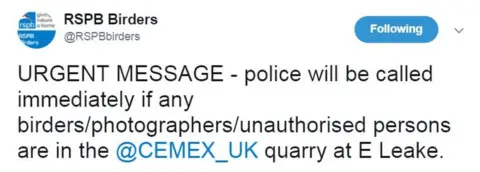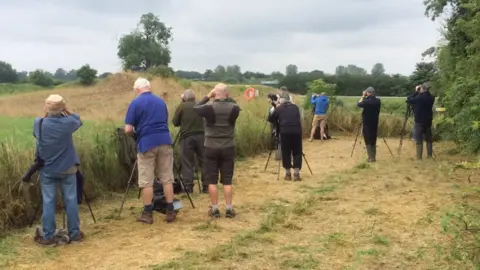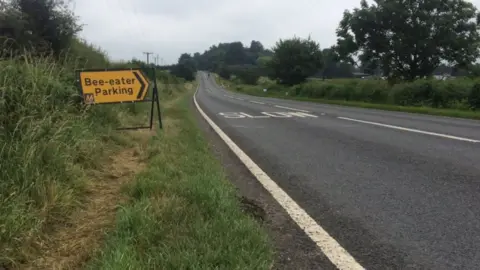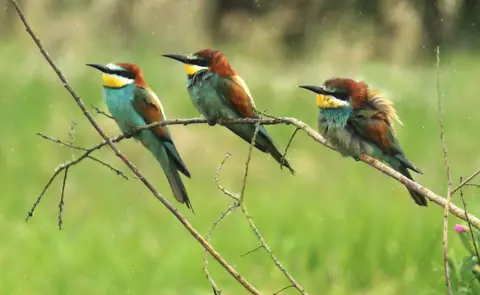Rare bee-eaters under 24-hour guard in East Leake quarry
Seven bee-eater birds rarely seen in the UK are under 24-hour guard at a quarry over fears any potential nests could be disturbed.
The birds, usually found in southern Europe, were first spotted at the quarry, in East Leake, Nottinghamshire, on Sunday.
Tim Sexton, of Nottinghamshire Wildlife Trust, said nest disturbance was a "constant worry" for conservationists.
Up to 2,000 people are expected to try and see the birds at the weekend.
 Sean Browne
Sean BrowneThe RSPB, which has set up a safe viewing area and a car-park to accommodate visitors, said trespassers would be reported to police.
Round-the-clock security has been brought in to prevent any nesting attempts by the birds being disturbed.
The charity tweeted: "... no need to trespass, risks everything. Keep out of quarry - simple!"
 Twitter
TwitterMr Sexton said now the "incredible" birds have settled he is expecting a few thousand people over the weekend, but encouraged visitors to view them from the designated watch point.
 Rob Hoare
Rob HoareThe quarry, owned by minerals firm Cemex, is still active and protected by fencing and CCTV.
The RSPB and the wildlife trust are also providing volunteers to not only give out information and help to birdwatchers, but also report trespassers.
The birds, which feast on bees and other flying insects, are likely to nest at the site and have probably travelled northwards because of climate change, the RSPB have said.
 Rspb
Rspb Rspb
RspbSpringwatch presenter Chris Packham said: "It's an exciting bird, they're made of a patchwork quilt of colours which make them very exotic.
"They're head of a vanguard of birds that are moving northwards thanks to climate change... we've had increasing numbers of these birds remaining into summer [in the UK] and breeding."
The birds, which burrow into sandy banks, nested in Cumbria in 2015, and on the Isle of Wight in 2014.

Bee-eaters
 Sean Browne
Sean Browne- Bee-eaters are normally nest in southern Europe and are a very rare breeding bird in the UK
- They nest in colonies in sandy banks often near rivers
- The birds can burrow in 10ft (3m) tunnels and usually lay clutches of four to nine eggs
- They can be seen tossing bees into the air after catching them
- Bee-eaters are a schedule one species, which means intentional or reckless disturbance of their nests is a criminal offence
Source: RSPB

